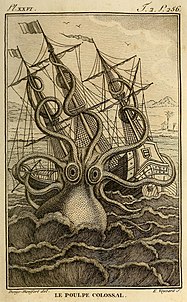
Back كركن Arabic Кракен Bulgarian ক্রাকেন Bengali/Bangla Kraken BS Kraken Catalan Kraken Czech Кракен CV Kraken Danish Riesenkraken (Mythologie) German Κράκεν Greek
The kraken (/ˈkrɑːkən/)[8] is a legendary sea monster of enormous size, per its etymology something akin to a cephalopod, said to appear in the sea between Norway and Iceland. It is believed that the legend of the Kraken may have originated from sightings of giant squid, which may grow to 12–15 m (40–50 feet) in length.
The kraken, as a subject of sailors' superstitions and mythos, was first described in the modern era in a travelogue by Francesco Negri in 1700. This description was followed in 1734 by an account from Dano-Norwegian missionary and explorer Hans Egede, who described the kraken in detail and equated it with the hafgufa of medieval lore. However, the first description of the creature is usually credited to the Danish bishop Pontoppidan (1753). Pontoppidan was the first to describe the kraken as an octopus (polypus) of tremendous size,[b] and wrote that it had a reputation for pulling down ships. The French malacologist Denys-Montfort, of the 19th century, is also known for his pioneering inquiries into the existence of gigantic octopuses (Octupi).
The great man-killing octopus entered French fiction when novelist Victor Hugo (1866) introduced the pieuvre octopus of Guernsey lore, which he identified with the kraken of legend. This led to Jules Verne's depiction of the kraken, although Verne did not distinguish between squid and octopus.
Linnaeus may have indirectly written about the kraken. Linnaeus wrote about the Microcosmus genus (an animal with various other organisms or growths attached to it, comprising a colony). Subsequent authors have referred to Linnaeus's writing, and the writings of Bartholin's cetus called hafgufa, and Paullini's monstrum marinum as "krakens".[c] That said, the claim that Linnaeus used the word "kraken" in the margin of a later edition of Systema Naturae has not been confirmed.
- ^ Cite error: The named reference
pennantwas invoked but never defined (see the help page). - ^ Cite error: The named reference
packardwas invoked but never defined (see the help page). - ^ Hamilton (1839). Plate XXX, p. 326a.
- ^ Cite error: The named reference
montgomery2016was invoked but never defined (see the help page). - ^ Denys-Montfort (1801), p. 256, Pl. XXVI.
- ^ Lee (1875), pp. 100–103.
- ^ Cite error: The named reference
nigg-woodcutwas invoked but never defined (see the help page). - ^ Cite error: The named reference
oed1-krakenwas invoked but never defined (see the help page).
Cite error: There are <ref group=lower-alpha> tags or {{efn}} templates on this page, but the references will not show without a {{reflist|group=lower-alpha}} template or {{notelist}} template (see the help page).


